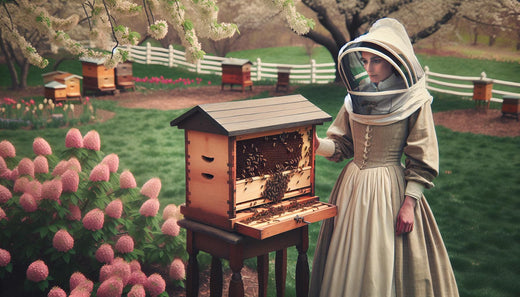Honeybees play a vital role in our ecosystem, pollinating plants and contributing to biodiversity. However, their swarming behavior can sometimes lead to challenges for beekeepers and homeowners. A honey bee swarm trap offers an effective solution to manage this behavior by capturing swarms before they settle in undesirable locations. Understanding how to use these traps effectively can make a significant difference in managing bee populations while ensuring their survival.
With the right tools and techniques, anyone can create and utilize a swarm trap that attracts honey bees and encourages them to settle in safe, controlled environments. This guide will delve into the essentials of honey bee swarm traps, including their design, placement, maintenance, and benefits. By employing these traps strategically, beekeepers can protect their hives, minimize swarming risks, and contribute to the overall health of the bee population.
What Are Honey Bee Swarm Traps?
Honey bee swarm traps are specially designed containers that mimic an ideal nesting site for honey bees. These traps are equipped with features that attract scout bees, making them appealing to swarming colonies searching for a new home. By capturing swarms, beekeepers can prevent colonies from establishing themselves in unwanted places, such as attics, walls, or outdoor structures.
Designing a Honey Bee Swarm Trap
Creating an effective honey bee swarm trap requires attention to several key design elements:
-
Dimensions: The ideal swarm trap has a volume of 10-12 liters, which accommodates most swarms comfortably.
-
Materials: Durable materials like wood or plastic are recommended. Waterproofing is essential to protect the trap from the elements.
-
Entrance: A small entrance of about 3-4 square inches allows bees easy access while deterring predators.
-
Bait: Natural baits like lemongrass oil or commercially available lures mimic the scent of a queen bee, attracting scout bees.
-
Ventilation: Proper ventilation ensures a healthy environment for the bees inside the trap.
Placement of Honey Bee Swarm Traps
Proper placement is crucial for the success of a swarm trap. Follow these guidelines to maximize your chances of attracting swarming bees:
-
Height: Position traps 10-15 feet above the ground, mimicking natural nesting sites like tree cavities.
-
Location: Select areas with high bee activity, such as gardens, flowering landscapes, or near existing hives.
-
Direction: Face the entrance towards the southeast to ensure exposure to the morning sun, which warms the trap and makes it more inviting.
-
Inspection: Regularly inspect traps every 7-10 days to monitor for activity and prevent overcrowding.
-
Maintenance: Clean traps after each use by removing debris or wax to avoid attracting pests. Store traps in a dry location between seasons to extend their lifespan.
Benefits of Using Honey Bee Swarm Traps
Using honey bee swarm traps offers several advantages, both for beekeepers and the environment:
1. Attracting Wild Honey Bees
Properly designed and baited swarm traps create an inviting environment for wild honey bees. The use of lemongrass oil or other natural scents enhances their attractiveness, while strategic placement near flowering plants increases the likelihood of captures.
2. Reducing Swarming Risks
Swarming can lead to the loss of bee colonies from established hives. By capturing swarms with traps, beekeepers can retain their colonies and reduce the risk of bees settling in inconvenient or unsafe locations.
3. Supporting Bee Population Health
Swarm traps contribute to the health and sustainability of the bee population by providing safe relocation opportunities. This proactive approach helps maintain ecological balance and supports pollination efforts.
Types of Honey Bee Swarm Traps
There are two main types of swarm traps, each suited to different needs:
Portable Swarm Traps
Portable traps are lightweight and easy to relocate. They are typically made from wood or plastic, with dimensions of 10-12 liters. These traps are ideal for areas with fluctuating bee activity, allowing beekeepers to adapt to changing conditions. Portable traps often include removable entrances for adjustability and are commonly baited with natural scents like lemongrass oil.
Permanent Swarm Traps
Permanent traps are more robust and designed for long-term use in specific locations. Constructed from durable materials, they are often larger than portable traps, providing ample space for larger swarms. These traps are best placed in areas with consistent bee activity, such as near flowering fields or established hives. Permanent traps require less frequent relocation and are an excellent choice for long-term swarm management.
How to Set Up a Honey Bee Swarm Trap
Setting up a swarm trap involves careful planning and execution. Here are the steps to ensure success:
1. Choose the Right Location
-
Proximity to Other Hives: Place traps near existing hives to increase the chances of attracting swarming bees.
-
High Bee Activity Areas: Select locations with abundant flowering plants.
-
Southeast Positioning: Position the entrance towards the southeast for sunlight exposure.
-
Height Considerations: Place traps 10-15 feet off the ground to mimic natural nesting sites.
2. Bait Your Trap
-
Use Natural Scents: Apply lemongrass oil, which mimics queen bee pheromones.
-
Add Sugary Solutions: Place a small container of diluted sugar syrup inside the trap for additional attraction.
-
Refresh Regularly: Reapply or refresh baits every few weeks during warmer months.
3. Inspect and Maintain
-
Regular Inspections: Check traps every 7-14 days to monitor for activity and ensure functionality.
-
Cleaning: Remove debris or wax after each use.
-
Storage: Store traps in a dry place during the off-season to prolong their usability.
Handling Captured Bees
When a swarm is captured, proper handling is essential to ensure the well-being of the bees and the success of their relocation:
-
Transporting Bees: Use a dark, ventilated container to minimize stress.
-
Timing: Capture bees in the evening to reduce disruption.
-
Introducing to New Hive: Allow the bees time to adjust before transferring them to a permanent hive.
Conclusion
Honey bee swarm traps are an invaluable tool for beekeepers and homeowners seeking to manage bee populations responsibly. By understanding these traps' design, placement, and maintenance, individuals can effectively capture swarms, reduce risks, and support ecological balance. With regular monitoring and proper care, swarm traps provide a practical, sustainable solution for managing honey bee swarming behavior.
Frequently Asked Questions
1. What is the purpose of honey bee swarm traps?
Honey bee swarm traps are designed to capture swarming bees before they settle in unwanted locations. By providing an appealing environment and using natural baits, these traps help beekeepers manage wild bee populations while promoting hive stability.
2. How do you construct a honey bee swarm trap?
To construct a swarm trap, use materials like wood or plastic with dimensions of 10-12 liters. Include a small entrance (3-4 square inches) and bait it with lemongrass oil or similar natural scents. Ensure the trap is waterproof and well-ventilated.
3. Where should I place a honey bee swarm trap?
Position swarm traps 10-15 feet off the ground in areas with high bee activity, such as near flowering plants or existing hives. Face the entrance towards the southeast to take advantage of morning sunlight.
4. What types of honey bee swarm traps are available?
There are two main types: portable and permanent. Portable traps are lightweight and easy to relocate, while permanent traps are more durable and designed for long-term use in fixed locations.
5. How often should I inspect my swarm trap?
Inspect your swarm trap every 7-14 days. Regular monitoring ensures the trap remains functional and appealing to swarming bees, while allowing you to address any issues promptly.



